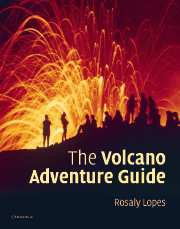Book contents
- Frontmatter
- Contents
- Preface
- Acknowledgments
- PART I Choosing a volcano to visit
- PART II Guides to volcanoes
- 6 Introduction to the field guides
- 7 Volcanoes in Hawaii
- 8 Volcanoes in the continental USA
- 9 Volcanoes in Italy
- 10 Volcanoes in Greece
- 11 Volcanoes in Iceland
- 12 Volcanoes in Costa Rica
- 13 Volcanoes in the West Indies
- Appendix I Useful information for preparing a volcano trip
- Appendix II Tours to volcanoes
- Bibliography
- Glossary
- Index
9 - Volcanoes in Italy
from PART II - Guides to volcanoes
Published online by Cambridge University Press: 01 September 2010
- Frontmatter
- Contents
- Preface
- Acknowledgments
- PART I Choosing a volcano to visit
- PART II Guides to volcanoes
- 6 Introduction to the field guides
- 7 Volcanoes in Hawaii
- 8 Volcanoes in the continental USA
- 9 Volcanoes in Italy
- 10 Volcanoes in Greece
- 11 Volcanoes in Iceland
- 12 Volcanoes in Costa Rica
- 13 Volcanoes in the West Indies
- Appendix I Useful information for preparing a volcano trip
- Appendix II Tours to volcanoes
- Bibliography
- Glossary
- Index
Summary
Southern Italy
Italian volcanoes are among the most notorious and dangerous in the world. Vulcano has given its name to all of the world's volcanoes, the Vesuvius eruption of AD 79 is probably the best–known volcanic event of all time, Strómboli is the longest continuously active volcano in the world, and Mt. Etna is the largest active volcano in Europe. Southern Italy has been the top destination for volcano enthusiasts for centuries and can be considered to be the cradle of volcanology. The historical records of eruptions in Italy go back some 2,000 years, providing a rich source of information on eruption mechanisms, cycles of activity, and on the effects of volcanic eruptions on society. Scientific observations of volcanic activity began on Vesuvius with Pliny the Younger's account of the AD 79 eruption. Vesuvius has the world's oldest volcano observatory, established in 1845, and was the first volcano to be monitored seismically, when the scientist Palmieri measured tremors during the 1872 eruption. Southern Italy's potentially disastrous combination of dangerous volcanoes and prosperous cities has long been a major drive in our need to understand and predict volcanic eruptions.
Most visitors to Italy are attracted to its incomparable historical sites, rich art collections, and splendid scenery. Those who have volcanoes as their focus can find all these elements plus spectacular volcanic scenery and, in the case of Strómboli, an almost guaranteed eruption in progress.
- Type
- Chapter
- Information
- The Volcano Adventure Guide , pp. 177 - 223Publisher: Cambridge University PressPrint publication year: 2005
- 1
- Cited by

